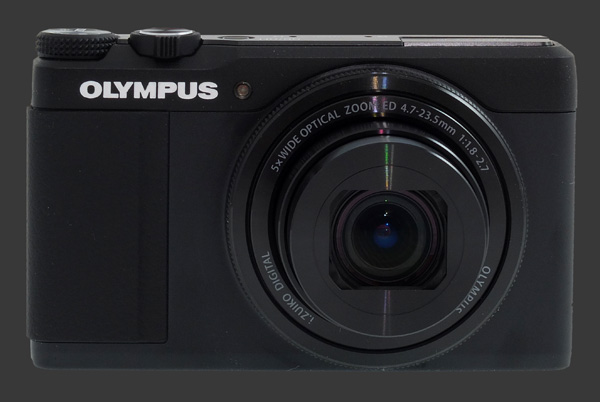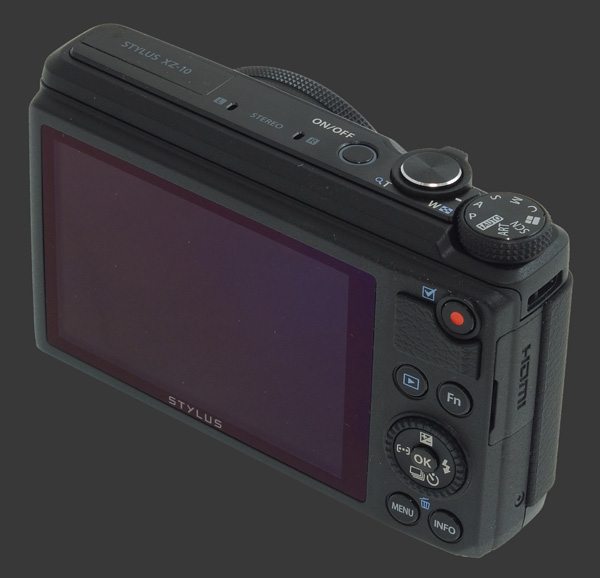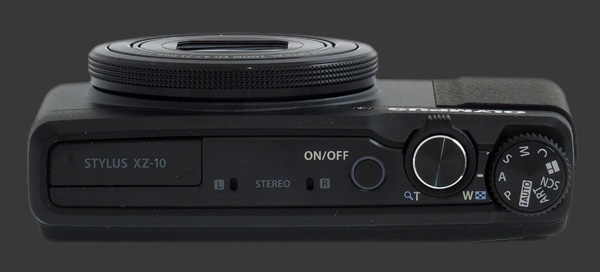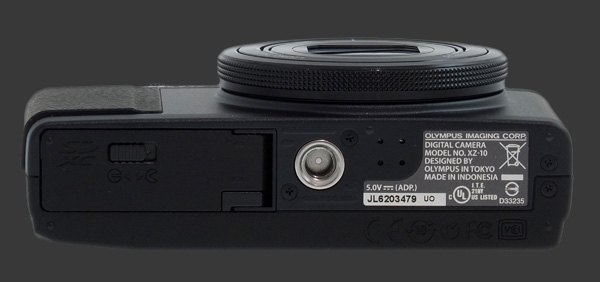Olympus Stylus XZ-10 Review
Olympus Stylus XZ-10 Introduction
The Olympus Stylus XZ-10 is an advanced compact camera that features full manual-controls and provides dual control-dials for efficiency. Launched roughly 4 months after the XZ-2
Olympus Stylus XZ-2, the XZ-10 can be seen as a more compact version of the former. Like the XZ-2, the Sylus XZ-10 has a very bright-lens, only very slightly so at F/1.8-2.7, only this time it is paired with a typical-sized 1/2.3" 12 megapixels CMOS sensor instead of a 10 MP CCD.
The 12 megapixels sensor of the Olympus XZ-10 has a native sensitivity range of ISO 100 to 1600, expandable to 6400. It shoots continuously at 5 FPS for up to 200 JPEG images which is very impressive for such a small camera. It can also capture 1080p HD video at 30 FPS.
The lens of this digital camera is stabilized and offers 5X optical zoom, from a wide 26mm to 130mm. The maximum aperture starts at an impressive F/1.8 and stops down to a respectable F/2.7 at the telephoto end.
The XZ-10 is considerably more versatile than most compact cameras. Its rather wide shutter-speed range going from 1/2000s to 30s makes it capable for freezing action and capturing very low-light scenes. A built-in 3-stop ND filter adds to the possibility to use wide apertures or slow shutter-speeds even with relatively bright light.
This feature set is ideal for photographers looking for a second light-weight camera to keep with but still be able to shoot creatively. It is also excellent for people wanting to learn photography without spending on a larger and more expensive ILC and lenses.
Olympus Stylus XZ-10 Capability - What can it do?
The Olympus XZ-10 is one of the most versatile fixed-lens digital cameras. Its extensive feature set is suitable for most photography subjects within the limits of its focal-range. The combined ultra-bright maximum aperture and ISO range lets the XZ-10 shoot hand-held with less light than most other fixed-lens cameras. The shutter-speed range is favorable to shooting at night from a tripod to obtain light-trails and record motion-blur for up to 30 seconds. In this review section, we describe each important feature and what it implies.
12 Megapixels CMOS Sensor
With 12 megapixels, this camera is suitable for sharp prints up to 12x16" as long as the ISO is kept low enough to prevent noise from destroying details. The imaging sensor has a 5.6X crop-factor which is typical of compact cameras. The XZ-10 can capture up to 5 FPS at full-resolution. A fast processor lets it do so continuously for up to 200 JPEG images which class-leading.
Stabilized 5X Wide-Angle Optical Zoom Lens
The 5X optical zoom range, equivalent to 26-130mm in 35mm-terms, is suitable for pictures of indoor scenes, landscapes and portraits. The wide-end can be used for architecture and interiors as long as they are not too large. The long end allows for portraits with a flattering perspective. Candid street photography, spectator sports and wildlife generally require a longer lens. The built-in stabilization system compensates for small involuntary movements of the photographer to capture still subjects when light is low. Moving subjects require fast shutter-speed, so stabilization is of little use with them.
Ultra-Bright F/1.8 Aperture
The exceptionally bright F/1.8 aperture, which only drops to F/2.7 at the long end, is the most significant asset of the Olympus XZ-10. This maximum aperture lets more light in and allows the XZ-10 to shoot at a lower ISO than most other cameras under the same circumstances. This compensates well for noise at high ISO sensitivities. The wide aperture also increases control over depth-of-field and allows images with a more background blur.

ISO 100-6400 Range
This wide ISO range covers bright to rather dim lighting conditions. This is typical of modern cameras which is accompanied by a reduction of image quality as ISO increases. The CMOS sensor in this camera uses back-side illumination to improve its ability to gather light. This is similar to most small modern cameras.
1/2000-30s Shutter-Speeds & 3-Stop ND Filter
The shutter-speed range is wider than most digital cameras and covers both action and night photography. The maximum shutter-speed of 1/2000 can freeze all but fast motorized sports. The Stylus XZ-10 rarely needs to go any faster in bright light unless shooting straight into the sun thanks to its optional neutral density filter.
With slow shutter-speeds reaching 30s usable until the top ISO of 6400, the XZ-10 can shoot in very low-light. A 30 second exposure is long enough to nicely photograph light trails of moving vehicles. The built-in 3-stop ND filter allows the camera to shoot at slower shutter-speeds for creative uses of slow shutter-speeds and wider apertures, reducing the sensitivity down an equivalent of ISO 12.
White-Balance
The Stylus XZ-10 is equipped with numerous and detailed white-balance controls. There is an automatic (AWB) setting, 6 presetsDaylight, Shadow, Cluody, Incandescent, Fluorescent, Flash and a custom white-balance function with two memories. All settings, even Auto and Custom can be fine-tuned along 2-axis in 15-steps. Each step is fine and allows good control over color rendition. There is also WB Bracketing which can vary white-balance along one or two axis with 3 steps along each. This means that either 3 or 9 files are produced from a single release of the shutter. Three step sizes which can be chosen independently on each axis.
Customizable Image Parameters
This camera has 5 Picture Modes which affects how it renders colors and details: Vivid, Natural, Muted, Portrait and Monotone. Contrast and sharpness is controllable in 5-steps for all modes. Gradation, meaning the tone-curve, can be set to Normal, Low Key, High Key or Auto. Saturation can be adjusted in 5-steps for color modes. Monotone produces a single-color image in one of 5 color-tones. There are also a number of simulated B&W filters for that mode.

Exposure Modes
All PASM exposure modes are available and dual-controls dials are there to control them efficiently. A Custom is there to save user settings. There are 14 typical scene modes plus a restricted Auto mode. Two scene modes are worth noting: HDR and Multiple-Exposure.
In addition to HDR and Multiple-Exposure, the XZ-10 offers a dedicated multiple-frame mode which combines up to 5 images into a collage with different arrangements and borders. There are a variety of styles to choose from which are previewed directly on the LCD while composing.
Metering & Exposure Compensation
There are 3 metering modes on Olympus XZ-10: Multi-Segment (ESP), Center-Weighed and Spot. These are the most common modes among advanced cameras. The availability of the Spot option allows to precisely select the mid-tone from a scene. All metering modes can be adjusted by ±3 stops, in 1/3 increments using Exposure-Compensation (EC) or Flash-Compensation (FC). These ranges are wider than on most point-and-shoot models.
The XZ-10 offers Auto-Exposure Bracketing (AEB). It takes 3 consecutive shots, one normal, one under-exposed and one over-exposed. The ordering cannot be changed to a more natural, under-normal-over. The increments between exposures is selectable between 1/3 and 1 EVs in 1/3 increments.
Continuous Drive & Self-Timers
There is a 2s and a 12s self-timer. A 5 FPS continuous drive mode can capture up to 200 JPEG images or 5 RAW files in a single burst. This is an excellent amount of buffering for a fixed-lens camera. The 15 FPS high-speed continuous drive mode can capture up to 60 frames at the reduced resolution of 2 MP.
It is worth noting that the XZ-10 selects sizes based on Large (L), Medium (M) or Small (S) which are configured in terms of resolution using the camera menu. This means that high-speed mode may use a lower resolution than required.
Built-In Flash
This compact digital camera has a built-in flash, set free via an electronic release. Pushing the flash down sets it to off. The flash range is unspecified but this is a rather small unit. There is no provision for an add-on flash either. The Olympus XZ-10 has Auto, Redeye, Fill, Fill & Redeye and Off flash modes. Flash can be manually controlled between full and 1/64 power, except in automatic modes other than Program.
SDXC Memory & Lithium-Ion Battery
The Olympus Stylus XZ-10 supports SDXC memory cards and therefore SDHC and SD cards, which are all the same shape but have different maximum capacities. SDHC cards are presently the cheapest type of memory and are available in various speeds. For HD video, a faster card is recommended. The camera is powered by a small proprietary lithium-ion battery which gives it a rather short battery-life of 240 shots according to the CIPA standard. The battery is unfortunately powered in-camera via its multi-function connector, so you cannot leave a battery charging while out shooting.
Olympus Stylus XZ-10 Usability - How easy is it to use?
The Olympus Stylus XZ-10 is a compact camera designed to be operated with two hands. The protruding lens barrel is surrounded by a mechanical ring which serves as the main control-dial. It has a textured surface and good detents which produce audible clicks. The left hand should therefore generally support the camera with the thumb and index finger operating the ring.
The right hand is naturally needed to operate the shutter-release. There is no actual grip at the front, only a faux-leather surface, so it would not feel secure to hold this camera with one hand. The index finger can easily move between the shutter-release and the zoom-controller which is wrapped around it.

The right-hand thumb rests on a textured rubber patch within easy reach of the video-recording button and the mode-dial. With a one inch movement downwards, the thumb can reach a thin ring around the 4-way controller which serves as the camera's secondary control-dial.
Every part of the Olympus XZ-10 feels solid, even battery compartment cover. The camera is light yet feels quite sturdy. Most likely due to the ultra-bright aperture of its lens, the lens barrel is large for a compact camera. This time though, Olympus managed to include a built-in lens cover, so there is no lens cap to lose.
Power on and off require a quick press of the power button which is located on the top-plate. To the right of the power button is a two-stage shutter-release with a soft halfway point. When the camera takes long to focus, it can therefore happen that a picture gets taken accidentally. Further to the right is the mode-dial with a textured outer ring and strong detents. All the way to the left is the popup flash.
The mode-dial has 9 positions. The usual 4 PASM modes are there, plus a custom mode, an auto mode along with 3 positions dedicated to scene modes, art filters and collages. Control-dials set different things depending on the current mode and, in some cases, do nothing.

In P mode, the front control-dial applies Program Shift by default. The rear control-dial sets EC but can control FC instead. In either case, it is easier to accidentally affect exposure than we would like. This can be disabled, so that a press of the Up direction of the 4-way controller enters EC mode but that becomes modal and turns accident-prone as well.
In A and S mode, the front control-dial changes the aperture or shutter-speed, respectively. The rear dial works exactly as in P mode. In M mode, each control dial sets an either aperture or shutter-speed. This leaves ISO to be set by the control panel or customizable function button.
At the back of the XZ-10 is a bright 3" LCD display with 920K pixels. The screen offers a choice of 5 brightness levels and 7 tints, although the steps of the latter are so fine, you would be hard-pressed to tell the difference. Although there is an optional live-histogram, it disappears when changing exposure which arguably is the most important time to see it.
At the top-right of the camera is a dedicated video-record button. There is no video mode on this camera which makes this the only way to capture video. This is truly unfortunate as there is no way to preview framing for video and the angle-of-view diminishes significantly so when filming. This almost made us abandon getting a sample video for it which explains the odd framing obtained even after dozens of attempts.
There is a Playback button above the 4-way controller. It works exactly as expected, toggling Playback mode on and off. It can also power-on the camera into Playback mode without extending the lens, just like most cameras without a modal power-switch.
Next to the Playback button is a customizable Function one. Unlike on most cameras, multiple functions can be assigned to that one button and pressing it repeatedly cycles through chosen settings. Since there is no button to select ISO, WB or the ND-Filter, those are most likely candidates for the Function button.

ISO is selectable in 1/3 stops which makes a lot of settings between ISO 100 and 6400. So can take a while to reach the desired ISO value. There is no way to customize the camera to only use full-stops. The 4-way controller which is used for navigating menus has functions assigned to each direction, including the central OK button:
- OK: Brings up an icon-based quick menu at the last used position. The quick menu gives access to: Image Stabilization, Picture Mode, White-Balance Drive, Aspect Ratio, Image Quality, Video Quality, Flash Mode, Flash Compensation, Metering, Focus Mode, ISO, Face Priority and ND Filter. The rear control-dial is used to select what to change and the front one control-dial changes it. This is extremely efficient.
- Up: Activates EC. Once active, the rear control-dial changes the value ±3 in 1/3 increments. It also makes the direction buttons change exposure parameters which makes it too easy change exposure accidentally.
- Right: Shows the flash options, the ones that do not apply to the current exposure mode appear greyed-out.
- Down: Shows drive mode options including bracketing (BKT) and self-timers. The BKT option is usually greyed-out because this one is only a toggle. Bracketing itself must be configured in the camera's menu. That determines if AEB or WBB will be used.
- Left: Controls focus by first showing the currently active focus-point(s). The either control-dial or directional buttons can be used to select a single focus point or all of them. At this point the Info button can be pressed to bring up focus-mode options.
For all options activated by the 4-way controller, the OK button can be pressed to confirm the selection and dismiss the menu. This is not necessary as the selected option is set regardless. When the OK button is pressed to bring up the quick menu, it does so at the last known position.
Although the quick menu can be used to change Picture Mode, White-Balance and Image Quality, it cannot be used to configure them. Any adjustments to parameters such as Sharpness, Saturation and Contrast has to be done through the menu system. The same is true for white-balance fine-tuning. Custom white-balance can be set though by pressing the Info button when the Custom White-Balance option is selected.
Below the 4-way controller are the Menu and Info buttons. These too work exactly as expected: Menu toggles the camera menu and Info cycles through various information screens.

The bottom of the XZ-10 has a metal tripod mount which is neither inline with the lens nor the center of the camera. It also has a sturdy door which covers the battery and memory-card compartment. The sides of the camera are bare, save for a small plastic door to access the HDMI and Multi I/O ports. The latter is used to charge the battery in-camera.
 |
Please Support Neocamera
All information on Neocamera is provided free of charge yet running this website is a huge endeavor. Purchases made via affiliate links found throughout the site help keep it running and up-to-date. There is no additional cost to you, so please consider buying via these links to our affilates:
If you found any information on this site valuable and did not purchase via our affiliate links, please considering donating via PayPal:
Any amount will be greatly appreaciated. Thank you for your support!
Olympus XZ-10 Highlights

Sensor-Size: 6 x 5mm

Actual size when viewed at 100 DPI
| 12 Megapixels Fixed Lens | ISO 100-6400 |
| 5X Wide Optical Zoom | Shutter 1/2000-30s |
| Built-in Stabilization | Full manual controls, including Manual Focus |
| 5 FPS Drive, 200 Images | Custom white-balance with 2 axis fine-tuning |
| 1920x1080 @ 30 FPS Video Recording | Spot-Metering |
| 3" LCD 920K Pixels | Lithium-Ion Battery |
| Secure Digital Extended Capacity |
Updates
2025.01.18

Fujifilm GFX 2025 Lens Roundup
Lens Review roundup of Fujifilm GFX Medium-Format lenses. Quality, performance and handling of the GF20-35mm F/4R WR, GF30mm F/3.5 Tilt-Shift and the GF55mm F/1.7.
2024.11.18

Best 2024 Photography Gifts for Every Budget
Great gifts for photographers and photo enthusiasts selected for every budget among the best products of 2024.
2024.08.07

Eye Protection Tips for Professional Photographers
The four main considerations for professional photographers regarding eyewear.
2024.07.14

Fujifilm X100VI Review
Flagship fixed-lens compact digital camera with a 40 MP sensor and Image-Stabilization, a first for the series. Retro design featuring dual control-dials, plus direct ISO, Shutter-Speed and EC dials. Its hybrid viewfinder can switch between EVF and OVF mode.
2024.05.09

Fujifilm GFX100 II Review
Flagship 102 Megapixels Medium-Format Mirrorless Digital Camera with 8-Stop 5-Axis IBIS, 8 FPS Drive, 8K Video and 400 MP Super-Resolution capture in a weatherproof and freezeproof body with dual control-dials and dual memory-card slots.
2024.04.03

Fujifilm X-T5 Review
Newest Fujifilm flagship boasting a 40 MP APS-C sensor, 5-axis IBIS with 7-stop efficiency, 15 FPS continuous drive, 6.2K Video capture, dual control-dials and dual SDXC UHS-II slots in a sturdy weatherproof and freezeproof body.
2023.11.20

Best Digital Cameras of 2023
Find out which are the Best Digital Cameras of 2023. All the new Mirrorless Digital Cameras from entry-level to high-end professional.
2023.07.10

Fujifilm X-H2 Review
40 Megapixels APS-C Hybrid Mirrorless Digital Camera with 7-stop IBIS. Fastest shutter ever and 8K video capture. Large builtin EVF with 0.8X magnification and 5.8 MP, plus an Eye-Start Sensor. Packed with features and large number of controls in a weatherproof and freezeproof body.
2023.05.07

Sony FE 20-70mm F/4G Review
Review of the unique Sony FE 20-70mm F/4G lens. The optical zoom of this lens spans ultra-wide-angle and medium focal-length coverage, making it one of the most versatile Full-Frame lenses on the market.
2023.01.15

Huion Inspiroy Dial 2 Review
Review of the Huion Inspiroy Dial 2 tablet, a medium sized drawing surface with dual dials and customizable buttons. Connects via USB-C or Bluetooth 5.0 with Windows, Linux and Android support.
2022.12.08

How to Pack for a Photo Trip
Find out how to pack for a travel photography trip, carry your gear safely while meeting airline regulations.
2022.11.13

Best Digital Cameras of 2022
The best digital cameras of 2022. A short list of the most outstanding models in their respective categories. Choose one for yourself or as a gift.













